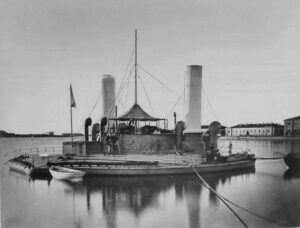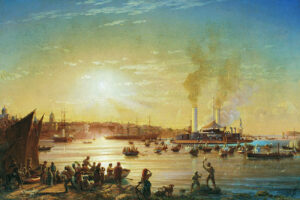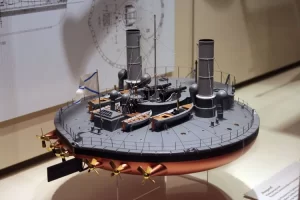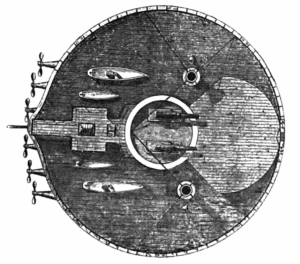
 The Russian ship, Novgorod was a “monitor” built for the Imperial Russian Navy in the 1870s. A monitor is “a relatively small warship that is neither fast nor strongly armored but carries disproportionately large guns.” These ships were used by various navies from the 1860s, during the First World War and also has a limited presence in the Second World War. Novgorod was one of the most unusual warships ever constructed, and it is still considered in “popular naval myth” as one of the worst warships ever built. Whether it was a good warship or not, it certainly was one of the funniest looking warships of all time.
The Russian ship, Novgorod was a “monitor” built for the Imperial Russian Navy in the 1870s. A monitor is “a relatively small warship that is neither fast nor strongly armored but carries disproportionately large guns.” These ships were used by various navies from the 1860s, during the First World War and also has a limited presence in the Second World War. Novgorod was one of the most unusual warships ever constructed, and it is still considered in “popular naval myth” as one of the worst warships ever built. Whether it was a good warship or not, it certainly was one of the funniest looking warships of all time.
While funny looking, Novgorod was relatively effective in her designed role as a coast-defense ship, and apparently there were reasons for the design of the ship. The hull was circular to reduce draught (In maritime terms, “draught” (also spelled “draft”) refers to the vertical distance between the waterline and the bottom of a ship’s hull (keel)123. It is a critical measurement that indicates how deep a vessel sits in the water.) Well, this ship definitely sat low in the water, so I guess “draught” was reduced with this funny looking ship. The design allowed the ship to carry much more armor and a heavier armament than other ships of the same size. While she was funny looking, Novgorod played a minor role in the Russo-Turkish War of 1877–78 and was reclassified as a coast-defense ironclad in 1892.
Scottish shipbuilder John Elder published an article in 1868, that indicated that widening the beam of a ship would reduce the area that needed to be protected and allow it to carry thicker armor and heavier, more powerful guns in comparison to a ship with a narrower beam, as was the typical practice of the day. I suppose that makes sense. The low riding craft might also be somewhat more difficult to see in battle. In addition, only a moderate increase in power would be required to match the speed of a normal ship. according to Elder. Then Director of Naval Construction of the Royal Navy, Sir Edward Reed, agreed with Elder’s conclusions. Rear-Admiral Andrei Alexandrovich Popov of the Imperial Russian Navy decided that to further expand on Elder’s concept by broadening the ship, and in the end, it was actually circular and flat-bottomed, unlike Elder’s convex hull, to further minimize its draught. Thus, the funny looking monitor (also known as a popovkas) was born.
In his book, The World’s Worst Warships, naval historian Antony Preston characterized the popovkas like this: “But in other respects, they were a dismal failure. They were too slow to stem the current in the Dniepr, and proved very difficult to steer. In practice the discharge of even one gun caused them to turn out of control and 
 even contra-rotating some of six propellers was unable to keep the ship on the correct heading. Nor could they cope with the rough weather which is frequently encountered in the Black Sea. They were prone to rapid rolling and pitching in anything more than a flat calm and could not aim or load their guns under such circumstances.” The Novgorod popovkas ship was decommissioned in 1903 and used as a storeship until she was sold for scrap in 1911.
even contra-rotating some of six propellers was unable to keep the ship on the correct heading. Nor could they cope with the rough weather which is frequently encountered in the Black Sea. They were prone to rapid rolling and pitching in anything more than a flat calm and could not aim or load their guns under such circumstances.” The Novgorod popovkas ship was decommissioned in 1903 and used as a storeship until she was sold for scrap in 1911.


Leave a Reply